Assessing the strengths and weaknesses of different approaches to leadership and management
VerifiedAdded on 2021/01/02
|14
|4612
|53
AI Summary
Management & Operation INTRODUCTION 3 LO13 P1 Define and compare the different roles and characteristics of a leader and a manager.3 M1 Analyse and differentiate between the role of a leader and function of a manager 4 LO25 P2: Different roles of leadership and management in applicationto different organisational situations 5 P3: Strengths and weakness of different approaches to leadership and management 6 M2 Assess the strengths and weaknesses of different manageresto situations within the work environment. 7 D1 Critical
Contribute Materials
Your contribution can guide someone’s learning journey. Share your
documents today.
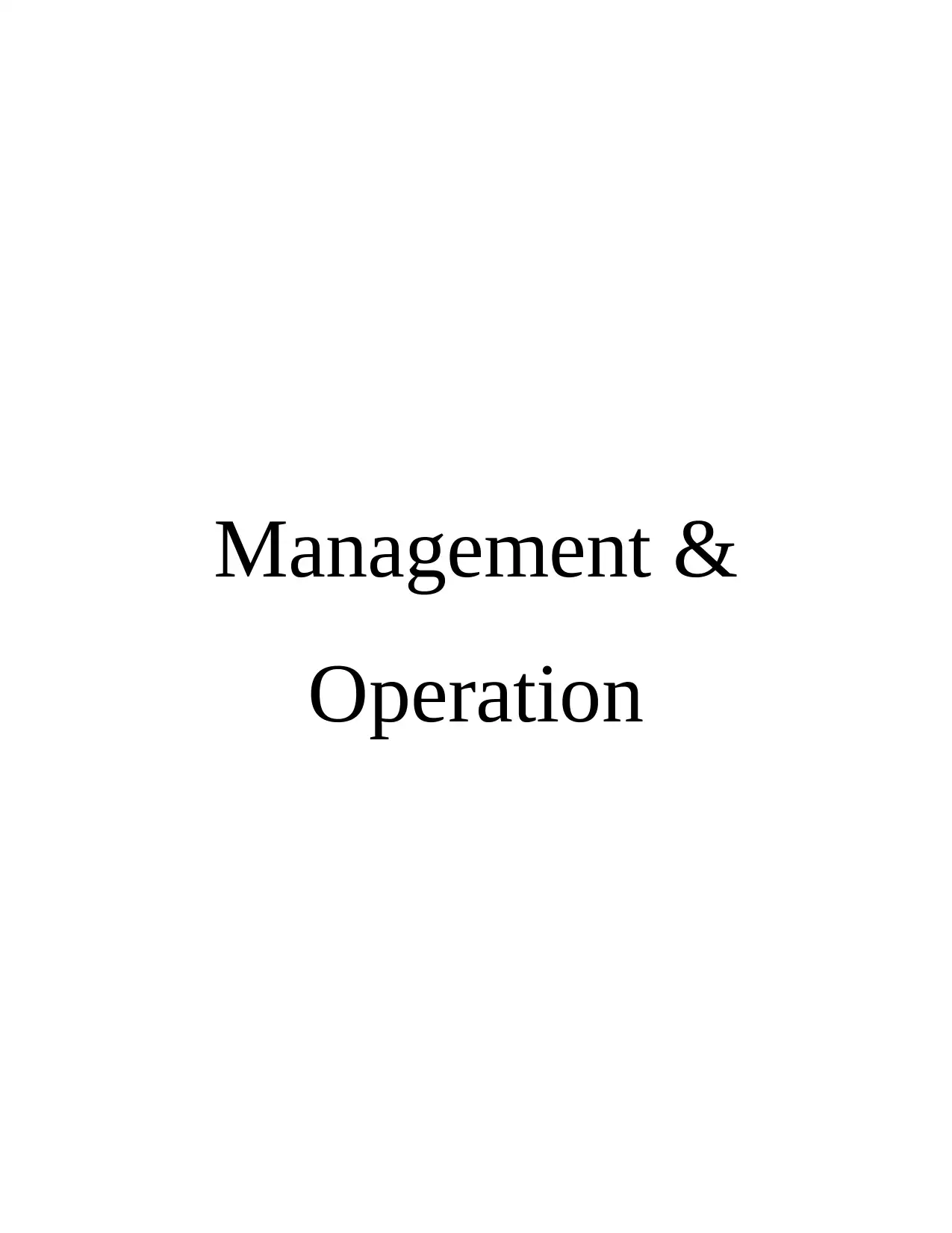
Management &
Operation
Operation
Secure Best Marks with AI Grader
Need help grading? Try our AI Grader for instant feedback on your assignments.
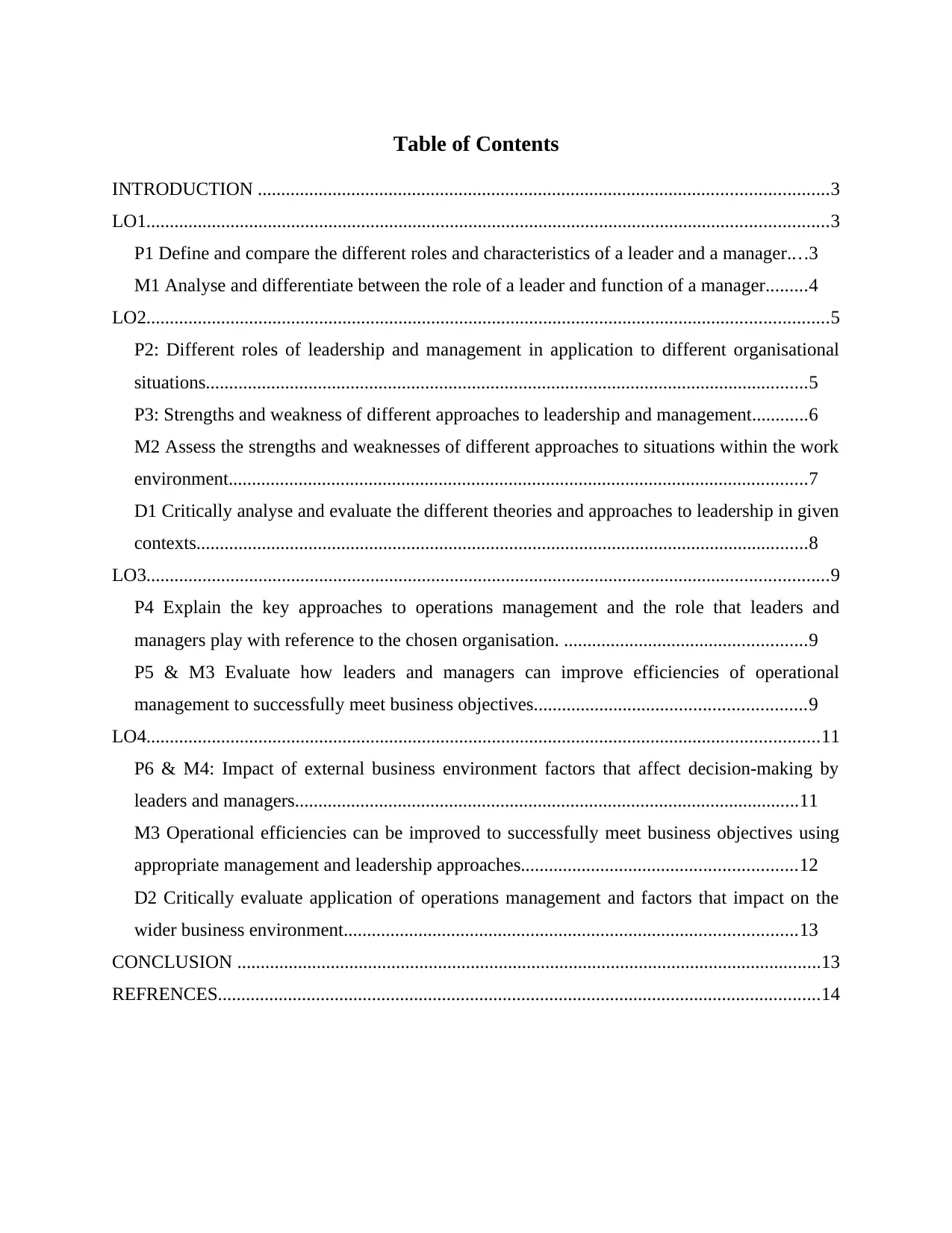
Table of Contents
INTRODUCTION ..........................................................................................................................3
LO1..................................................................................................................................................3
P1 Define and compare the different roles and characteristics of a leader and a manager....3
M1 Analyse and differentiate between the role of a leader and function of a manager.........4
LO2..................................................................................................................................................5
P2: Different roles of leadership and management in application to different organisational
situations.................................................................................................................................5
P3: Strengths and weakness of different approaches to leadership and management............6
M2 Assess the strengths and weaknesses of different approaches to situations within the work
environment............................................................................................................................7
D1 Critically analyse and evaluate the different theories and approaches to leadership in given
contexts...................................................................................................................................8
LO3..................................................................................................................................................9
P4 Explain the key approaches to operations management and the role that leaders and
managers play with reference to the chosen organisation. ....................................................9
P5 & M3 Evaluate how leaders and managers can improve efficiencies of operational
management to successfully meet business objectives..........................................................9
LO4................................................................................................................................................11
P6 & M4: Impact of external business environment factors that affect decision-making by
leaders and managers............................................................................................................11
M3 Operational efficiencies can be improved to successfully meet business objectives using
appropriate management and leadership approaches...........................................................12
D2 Critically evaluate application of operations management and factors that impact on the
wider business environment.................................................................................................13
CONCLUSION .............................................................................................................................13
REFRENCES.................................................................................................................................14
INTRODUCTION ..........................................................................................................................3
LO1..................................................................................................................................................3
P1 Define and compare the different roles and characteristics of a leader and a manager....3
M1 Analyse and differentiate between the role of a leader and function of a manager.........4
LO2..................................................................................................................................................5
P2: Different roles of leadership and management in application to different organisational
situations.................................................................................................................................5
P3: Strengths and weakness of different approaches to leadership and management............6
M2 Assess the strengths and weaknesses of different approaches to situations within the work
environment............................................................................................................................7
D1 Critically analyse and evaluate the different theories and approaches to leadership in given
contexts...................................................................................................................................8
LO3..................................................................................................................................................9
P4 Explain the key approaches to operations management and the role that leaders and
managers play with reference to the chosen organisation. ....................................................9
P5 & M3 Evaluate how leaders and managers can improve efficiencies of operational
management to successfully meet business objectives..........................................................9
LO4................................................................................................................................................11
P6 & M4: Impact of external business environment factors that affect decision-making by
leaders and managers............................................................................................................11
M3 Operational efficiencies can be improved to successfully meet business objectives using
appropriate management and leadership approaches...........................................................12
D2 Critically evaluate application of operations management and factors that impact on the
wider business environment.................................................................................................13
CONCLUSION .............................................................................................................................13
REFRENCES.................................................................................................................................14
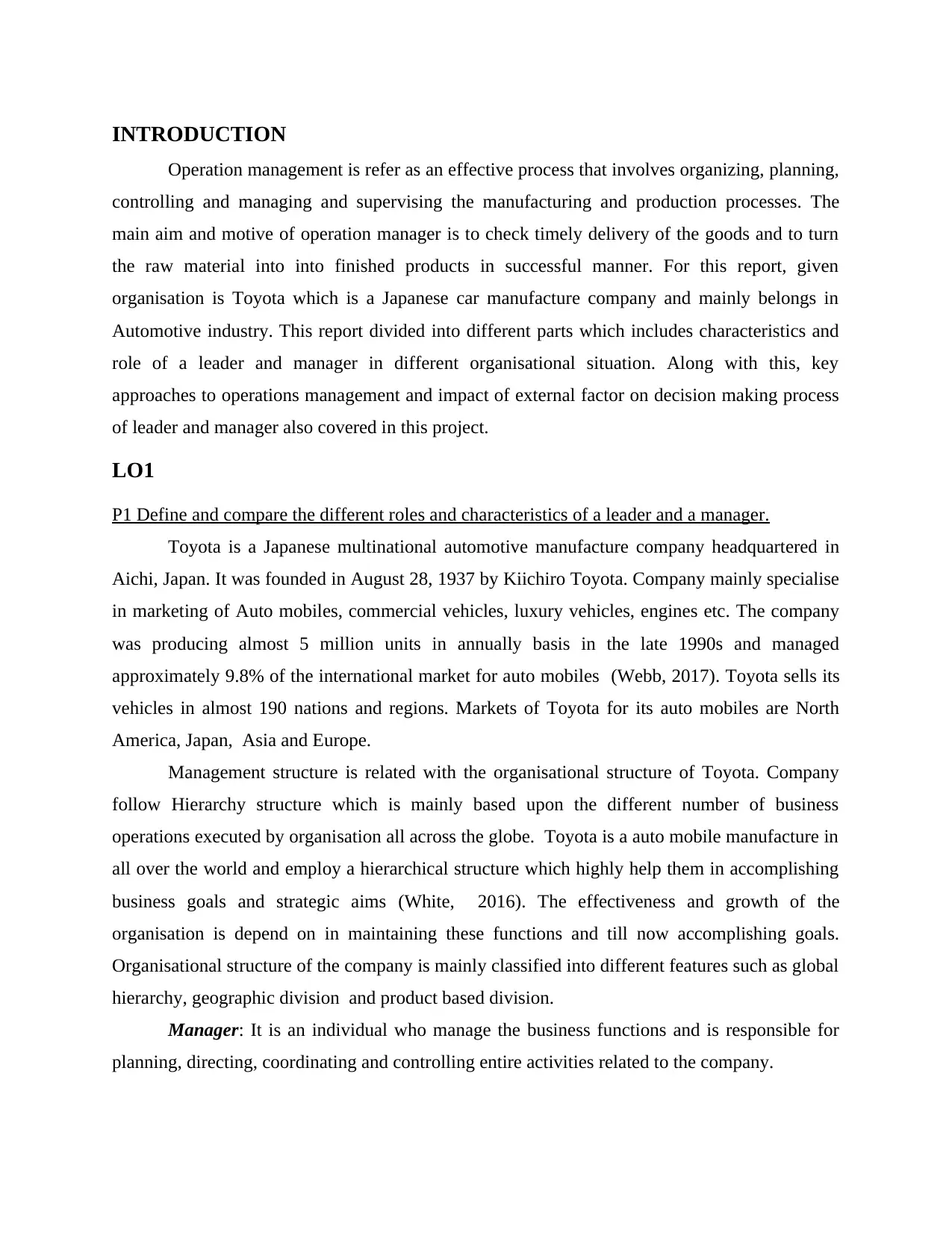
INTRODUCTION
Operation management is refer as an effective process that involves organizing, planning,
controlling and managing and supervising the manufacturing and production processes. The
main aim and motive of operation manager is to check timely delivery of the goods and to turn
the raw material into into finished products in successful manner. For this report, given
organisation is Toyota which is a Japanese car manufacture company and mainly belongs in
Automotive industry. This report divided into different parts which includes characteristics and
role of a leader and manager in different organisational situation. Along with this, key
approaches to operations management and impact of external factor on decision making process
of leader and manager also covered in this project.
LO1
P1 Define and compare the different roles and characteristics of a leader and a manager.
Toyota is a Japanese multinational automotive manufacture company headquartered in
Aichi, Japan. It was founded in August 28, 1937 by Kiichiro Toyota. Company mainly specialise
in marketing of Auto mobiles, commercial vehicles, luxury vehicles, engines etc. The company
was producing almost 5 million units in annually basis in the late 1990s and managed
approximately 9.8% of the international market for auto mobiles (Webb, 2017). Toyota sells its
vehicles in almost 190 nations and regions. Markets of Toyota for its auto mobiles are North
America, Japan, Asia and Europe.
Management structure is related with the organisational structure of Toyota. Company
follow Hierarchy structure which is mainly based upon the different number of business
operations executed by organisation all across the globe. Toyota is a auto mobile manufacture in
all over the world and employ a hierarchical structure which highly help them in accomplishing
business goals and strategic aims (White, 2016). The effectiveness and growth of the
organisation is depend on in maintaining these functions and till now accomplishing goals.
Organisational structure of the company is mainly classified into different features such as global
hierarchy, geographic division and product based division.
Manager: It is an individual who manage the business functions and is responsible for
planning, directing, coordinating and controlling entire activities related to the company.
Operation management is refer as an effective process that involves organizing, planning,
controlling and managing and supervising the manufacturing and production processes. The
main aim and motive of operation manager is to check timely delivery of the goods and to turn
the raw material into into finished products in successful manner. For this report, given
organisation is Toyota which is a Japanese car manufacture company and mainly belongs in
Automotive industry. This report divided into different parts which includes characteristics and
role of a leader and manager in different organisational situation. Along with this, key
approaches to operations management and impact of external factor on decision making process
of leader and manager also covered in this project.
LO1
P1 Define and compare the different roles and characteristics of a leader and a manager.
Toyota is a Japanese multinational automotive manufacture company headquartered in
Aichi, Japan. It was founded in August 28, 1937 by Kiichiro Toyota. Company mainly specialise
in marketing of Auto mobiles, commercial vehicles, luxury vehicles, engines etc. The company
was producing almost 5 million units in annually basis in the late 1990s and managed
approximately 9.8% of the international market for auto mobiles (Webb, 2017). Toyota sells its
vehicles in almost 190 nations and regions. Markets of Toyota for its auto mobiles are North
America, Japan, Asia and Europe.
Management structure is related with the organisational structure of Toyota. Company
follow Hierarchy structure which is mainly based upon the different number of business
operations executed by organisation all across the globe. Toyota is a auto mobile manufacture in
all over the world and employ a hierarchical structure which highly help them in accomplishing
business goals and strategic aims (White, 2016). The effectiveness and growth of the
organisation is depend on in maintaining these functions and till now accomplishing goals.
Organisational structure of the company is mainly classified into different features such as global
hierarchy, geographic division and product based division.
Manager: It is an individual who manage the business functions and is responsible for
planning, directing, coordinating and controlling entire activities related to the company.
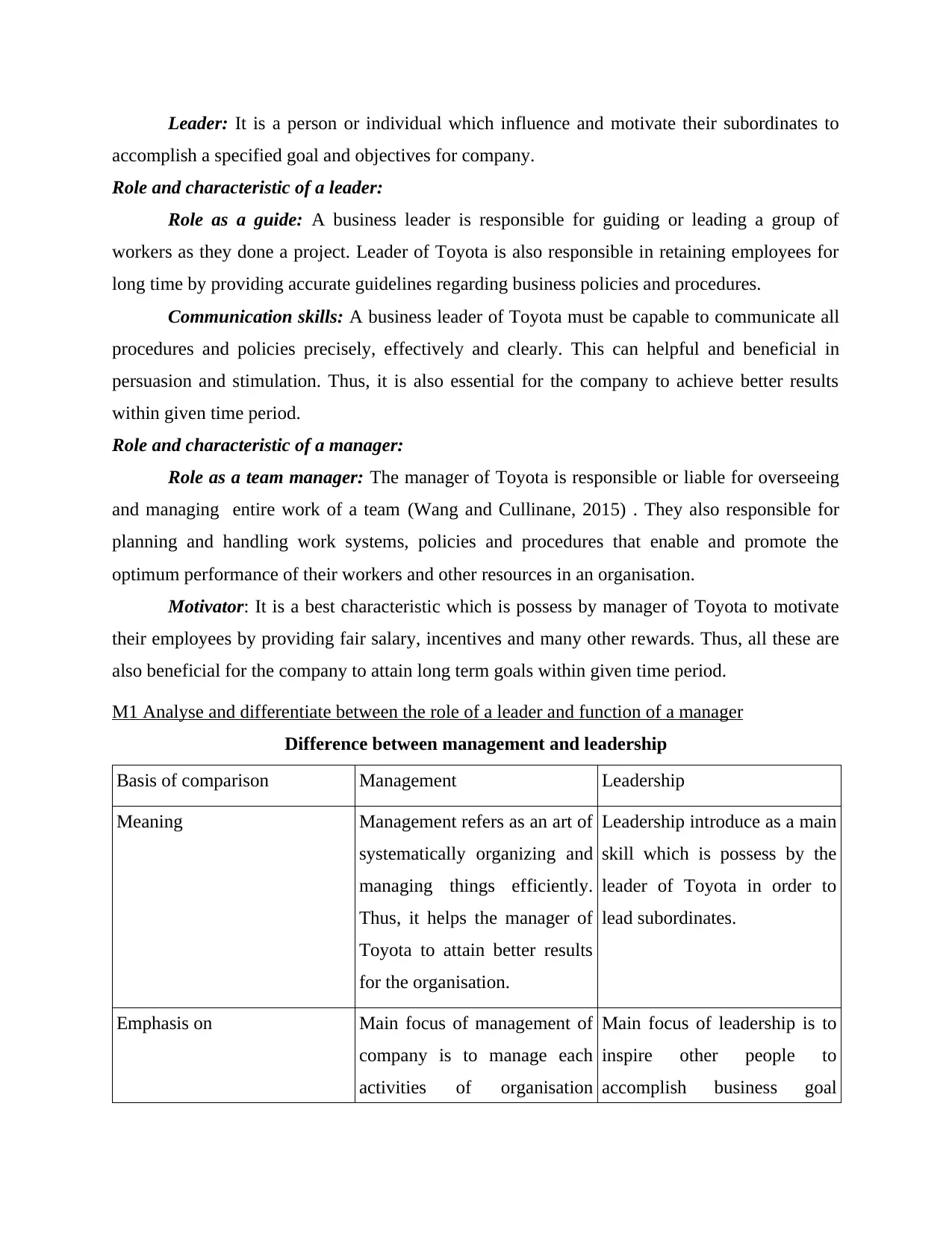
Leader: It is a person or individual which influence and motivate their subordinates to
accomplish a specified goal and objectives for company.
Role and characteristic of a leader:
Role as a guide: A business leader is responsible for guiding or leading a group of
workers as they done a project. Leader of Toyota is also responsible in retaining employees for
long time by providing accurate guidelines regarding business policies and procedures.
Communication skills: A business leader of Toyota must be capable to communicate all
procedures and policies precisely, effectively and clearly. This can helpful and beneficial in
persuasion and stimulation. Thus, it is also essential for the company to achieve better results
within given time period.
Role and characteristic of a manager:
Role as a team manager: The manager of Toyota is responsible or liable for overseeing
and managing entire work of a team (Wang and Cullinane, 2015) . They also responsible for
planning and handling work systems, policies and procedures that enable and promote the
optimum performance of their workers and other resources in an organisation.
Motivator: It is a best characteristic which is possess by manager of Toyota to motivate
their employees by providing fair salary, incentives and many other rewards. Thus, all these are
also beneficial for the company to attain long term goals within given time period.
M1 Analyse and differentiate between the role of a leader and function of a manager
Difference between management and leadership
Basis of comparison Management Leadership
Meaning Management refers as an art of
systematically organizing and
managing things efficiently.
Thus, it helps the manager of
Toyota to attain better results
for the organisation.
Leadership introduce as a main
skill which is possess by the
leader of Toyota in order to
lead subordinates.
Emphasis on Main focus of management of
company is to manage each
activities of organisation
Main focus of leadership is to
inspire other people to
accomplish business goal
accomplish a specified goal and objectives for company.
Role and characteristic of a leader:
Role as a guide: A business leader is responsible for guiding or leading a group of
workers as they done a project. Leader of Toyota is also responsible in retaining employees for
long time by providing accurate guidelines regarding business policies and procedures.
Communication skills: A business leader of Toyota must be capable to communicate all
procedures and policies precisely, effectively and clearly. This can helpful and beneficial in
persuasion and stimulation. Thus, it is also essential for the company to achieve better results
within given time period.
Role and characteristic of a manager:
Role as a team manager: The manager of Toyota is responsible or liable for overseeing
and managing entire work of a team (Wang and Cullinane, 2015) . They also responsible for
planning and handling work systems, policies and procedures that enable and promote the
optimum performance of their workers and other resources in an organisation.
Motivator: It is a best characteristic which is possess by manager of Toyota to motivate
their employees by providing fair salary, incentives and many other rewards. Thus, all these are
also beneficial for the company to attain long term goals within given time period.
M1 Analyse and differentiate between the role of a leader and function of a manager
Difference between management and leadership
Basis of comparison Management Leadership
Meaning Management refers as an art of
systematically organizing and
managing things efficiently.
Thus, it helps the manager of
Toyota to attain better results
for the organisation.
Leadership introduce as a main
skill which is possess by the
leader of Toyota in order to
lead subordinates.
Emphasis on Main focus of management of
company is to manage each
activities of organisation
Main focus of leadership is to
inspire other people to
accomplish business goal
Secure Best Marks with AI Grader
Need help grading? Try our AI Grader for instant feedback on your assignments.
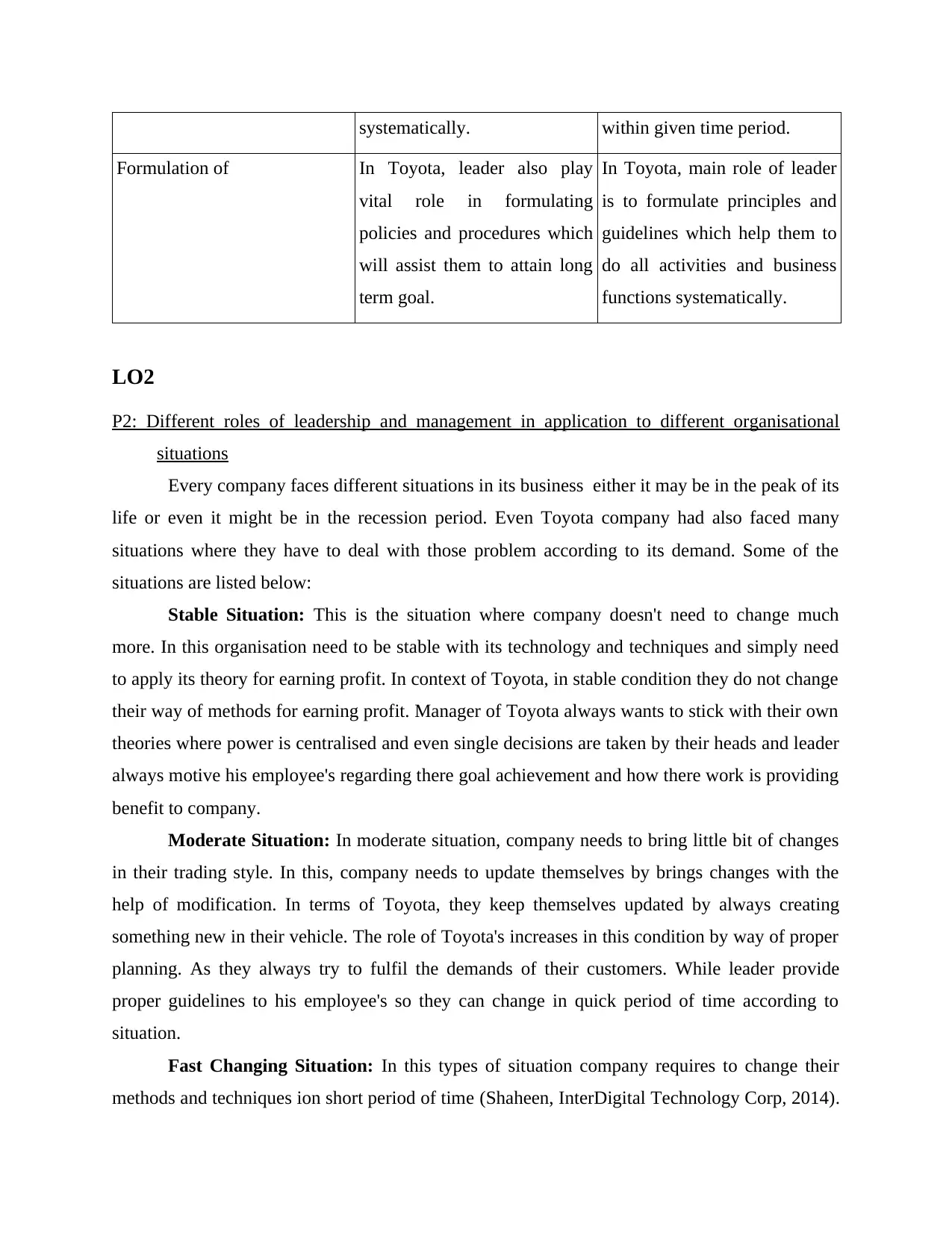
systematically. within given time period.
Formulation of In Toyota, leader also play
vital role in formulating
policies and procedures which
will assist them to attain long
term goal.
In Toyota, main role of leader
is to formulate principles and
guidelines which help them to
do all activities and business
functions systematically.
LO2
P2: Different roles of leadership and management in application to different organisational
situations
Every company faces different situations in its business either it may be in the peak of its
life or even it might be in the recession period. Even Toyota company had also faced many
situations where they have to deal with those problem according to its demand. Some of the
situations are listed below:
Stable Situation: This is the situation where company doesn't need to change much
more. In this organisation need to be stable with its technology and techniques and simply need
to apply its theory for earning profit. In context of Toyota, in stable condition they do not change
their way of methods for earning profit. Manager of Toyota always wants to stick with their own
theories where power is centralised and even single decisions are taken by their heads and leader
always motive his employee's regarding there goal achievement and how there work is providing
benefit to company.
Moderate Situation: In moderate situation, company needs to bring little bit of changes
in their trading style. In this, company needs to update themselves by brings changes with the
help of modification. In terms of Toyota, they keep themselves updated by always creating
something new in their vehicle. The role of Toyota's increases in this condition by way of proper
planning. As they always try to fulfil the demands of their customers. While leader provide
proper guidelines to his employee's so they can change in quick period of time according to
situation.
Fast Changing Situation: In this types of situation company requires to change their
methods and techniques ion short period of time (Shaheen, InterDigital Technology Corp, 2014).
Formulation of In Toyota, leader also play
vital role in formulating
policies and procedures which
will assist them to attain long
term goal.
In Toyota, main role of leader
is to formulate principles and
guidelines which help them to
do all activities and business
functions systematically.
LO2
P2: Different roles of leadership and management in application to different organisational
situations
Every company faces different situations in its business either it may be in the peak of its
life or even it might be in the recession period. Even Toyota company had also faced many
situations where they have to deal with those problem according to its demand. Some of the
situations are listed below:
Stable Situation: This is the situation where company doesn't need to change much
more. In this organisation need to be stable with its technology and techniques and simply need
to apply its theory for earning profit. In context of Toyota, in stable condition they do not change
their way of methods for earning profit. Manager of Toyota always wants to stick with their own
theories where power is centralised and even single decisions are taken by their heads and leader
always motive his employee's regarding there goal achievement and how there work is providing
benefit to company.
Moderate Situation: In moderate situation, company needs to bring little bit of changes
in their trading style. In this, company needs to update themselves by brings changes with the
help of modification. In terms of Toyota, they keep themselves updated by always creating
something new in their vehicle. The role of Toyota's increases in this condition by way of proper
planning. As they always try to fulfil the demands of their customers. While leader provide
proper guidelines to his employee's so they can change in quick period of time according to
situation.
Fast Changing Situation: In this types of situation company requires to change their
methods and techniques ion short period of time (Shaheen, InterDigital Technology Corp, 2014).
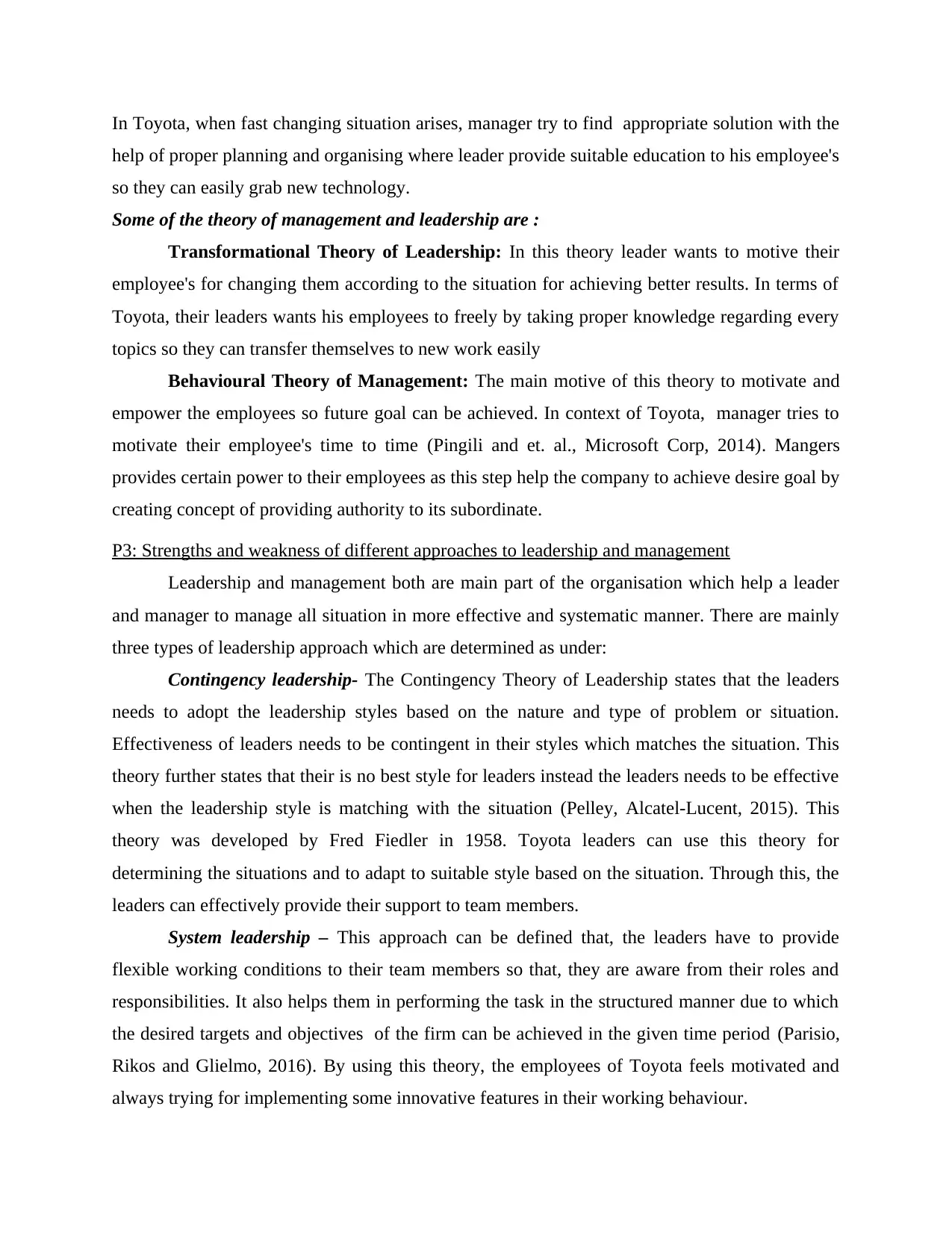
In Toyota, when fast changing situation arises, manager try to find appropriate solution with the
help of proper planning and organising where leader provide suitable education to his employee's
so they can easily grab new technology.
Some of the theory of management and leadership are :
Transformational Theory of Leadership: In this theory leader wants to motive their
employee's for changing them according to the situation for achieving better results. In terms of
Toyota, their leaders wants his employees to freely by taking proper knowledge regarding every
topics so they can transfer themselves to new work easily
Behavioural Theory of Management: The main motive of this theory to motivate and
empower the employees so future goal can be achieved. In context of Toyota, manager tries to
motivate their employee's time to time (Pingili and et. al., Microsoft Corp, 2014). Mangers
provides certain power to their employees as this step help the company to achieve desire goal by
creating concept of providing authority to its subordinate.
P3: Strengths and weakness of different approaches to leadership and management
Leadership and management both are main part of the organisation which help a leader
and manager to manage all situation in more effective and systematic manner. There are mainly
three types of leadership approach which are determined as under:
Contingency leadership- The Contingency Theory of Leadership states that the leaders
needs to adopt the leadership styles based on the nature and type of problem or situation.
Effectiveness of leaders needs to be contingent in their styles which matches the situation. This
theory further states that their is no best style for leaders instead the leaders needs to be effective
when the leadership style is matching with the situation (Pelley, Alcatel-Lucent, 2015). This
theory was developed by Fred Fiedler in 1958. Toyota leaders can use this theory for
determining the situations and to adapt to suitable style based on the situation. Through this, the
leaders can effectively provide their support to team members.
System leadership – This approach can be defined that, the leaders have to provide
flexible working conditions to their team members so that, they are aware from their roles and
responsibilities. It also helps them in performing the task in the structured manner due to which
the desired targets and objectives of the firm can be achieved in the given time period (Parisio,
Rikos and Glielmo, 2016). By using this theory, the employees of Toyota feels motivated and
always trying for implementing some innovative features in their working behaviour.
help of proper planning and organising where leader provide suitable education to his employee's
so they can easily grab new technology.
Some of the theory of management and leadership are :
Transformational Theory of Leadership: In this theory leader wants to motive their
employee's for changing them according to the situation for achieving better results. In terms of
Toyota, their leaders wants his employees to freely by taking proper knowledge regarding every
topics so they can transfer themselves to new work easily
Behavioural Theory of Management: The main motive of this theory to motivate and
empower the employees so future goal can be achieved. In context of Toyota, manager tries to
motivate their employee's time to time (Pingili and et. al., Microsoft Corp, 2014). Mangers
provides certain power to their employees as this step help the company to achieve desire goal by
creating concept of providing authority to its subordinate.
P3: Strengths and weakness of different approaches to leadership and management
Leadership and management both are main part of the organisation which help a leader
and manager to manage all situation in more effective and systematic manner. There are mainly
three types of leadership approach which are determined as under:
Contingency leadership- The Contingency Theory of Leadership states that the leaders
needs to adopt the leadership styles based on the nature and type of problem or situation.
Effectiveness of leaders needs to be contingent in their styles which matches the situation. This
theory further states that their is no best style for leaders instead the leaders needs to be effective
when the leadership style is matching with the situation (Pelley, Alcatel-Lucent, 2015). This
theory was developed by Fred Fiedler in 1958. Toyota leaders can use this theory for
determining the situations and to adapt to suitable style based on the situation. Through this, the
leaders can effectively provide their support to team members.
System leadership – This approach can be defined that, the leaders have to provide
flexible working conditions to their team members so that, they are aware from their roles and
responsibilities. It also helps them in performing the task in the structured manner due to which
the desired targets and objectives of the firm can be achieved in the given time period (Parisio,
Rikos and Glielmo, 2016). By using this theory, the employees of Toyota feels motivated and
always trying for implementing some innovative features in their working behaviour.
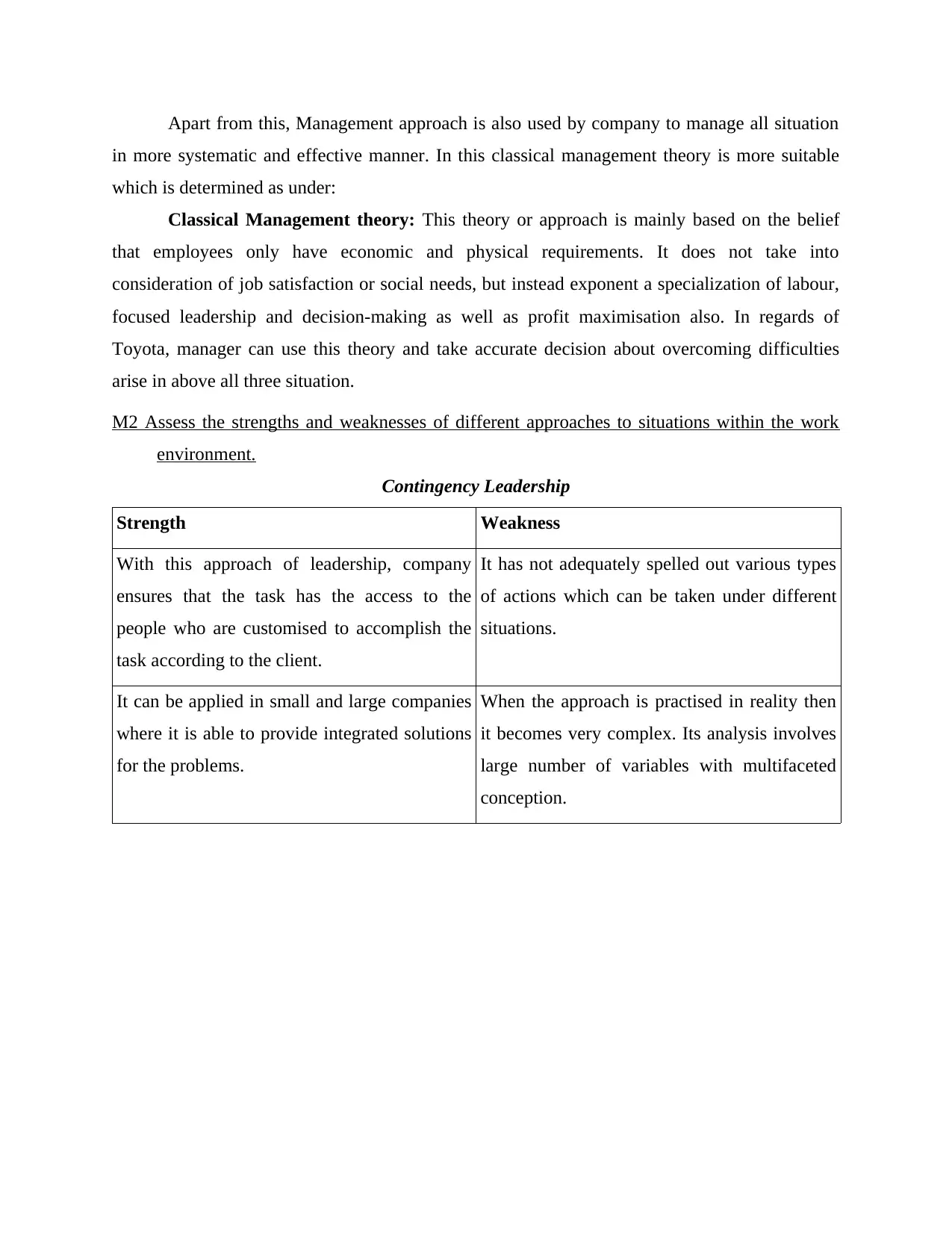
Apart from this, Management approach is also used by company to manage all situation
in more systematic and effective manner. In this classical management theory is more suitable
which is determined as under:
Classical Management theory: This theory or approach is mainly based on the belief
that employees only have economic and physical requirements. It does not take into
consideration of job satisfaction or social needs, but instead exponent a specialization of labour,
focused leadership and decision-making as well as profit maximisation also. In regards of
Toyota, manager can use this theory and take accurate decision about overcoming difficulties
arise in above all three situation.
M2 Assess the strengths and weaknesses of different approaches to situations within the work
environment.
Contingency Leadership
Strength Weakness
With this approach of leadership, company
ensures that the task has the access to the
people who are customised to accomplish the
task according to the client.
It has not adequately spelled out various types
of actions which can be taken under different
situations.
It can be applied in small and large companies
where it is able to provide integrated solutions
for the problems.
When the approach is practised in reality then
it becomes very complex. Its analysis involves
large number of variables with multifaceted
conception.
in more systematic and effective manner. In this classical management theory is more suitable
which is determined as under:
Classical Management theory: This theory or approach is mainly based on the belief
that employees only have economic and physical requirements. It does not take into
consideration of job satisfaction or social needs, but instead exponent a specialization of labour,
focused leadership and decision-making as well as profit maximisation also. In regards of
Toyota, manager can use this theory and take accurate decision about overcoming difficulties
arise in above all three situation.
M2 Assess the strengths and weaknesses of different approaches to situations within the work
environment.
Contingency Leadership
Strength Weakness
With this approach of leadership, company
ensures that the task has the access to the
people who are customised to accomplish the
task according to the client.
It has not adequately spelled out various types
of actions which can be taken under different
situations.
It can be applied in small and large companies
where it is able to provide integrated solutions
for the problems.
When the approach is practised in reality then
it becomes very complex. Its analysis involves
large number of variables with multifaceted
conception.
Paraphrase This Document
Need a fresh take? Get an instant paraphrase of this document with our AI Paraphraser
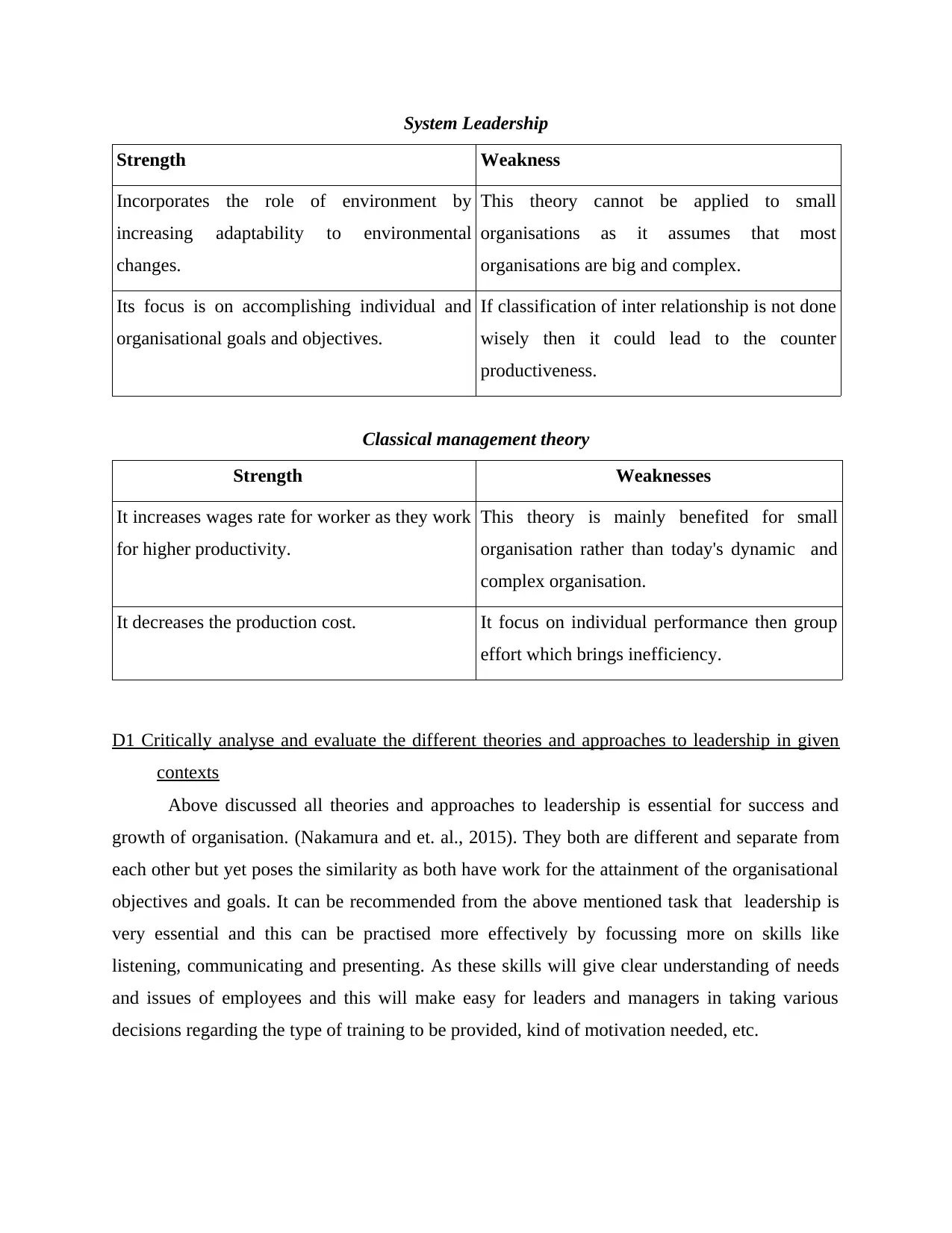
System Leadership
Strength Weakness
Incorporates the role of environment by
increasing adaptability to environmental
changes.
This theory cannot be applied to small
organisations as it assumes that most
organisations are big and complex.
Its focus is on accomplishing individual and
organisational goals and objectives.
If classification of inter relationship is not done
wisely then it could lead to the counter
productiveness.
Classical management theory
Strength Weaknesses
It increases wages rate for worker as they work
for higher productivity.
This theory is mainly benefited for small
organisation rather than today's dynamic and
complex organisation.
It decreases the production cost. It focus on individual performance then group
effort which brings inefficiency.
D1 Critically analyse and evaluate the different theories and approaches to leadership in given
contexts
Above discussed all theories and approaches to leadership is essential for success and
growth of organisation. (Nakamura and et. al., 2015). They both are different and separate from
each other but yet poses the similarity as both have work for the attainment of the organisational
objectives and goals. It can be recommended from the above mentioned task that leadership is
very essential and this can be practised more effectively by focussing more on skills like
listening, communicating and presenting. As these skills will give clear understanding of needs
and issues of employees and this will make easy for leaders and managers in taking various
decisions regarding the type of training to be provided, kind of motivation needed, etc.
Strength Weakness
Incorporates the role of environment by
increasing adaptability to environmental
changes.
This theory cannot be applied to small
organisations as it assumes that most
organisations are big and complex.
Its focus is on accomplishing individual and
organisational goals and objectives.
If classification of inter relationship is not done
wisely then it could lead to the counter
productiveness.
Classical management theory
Strength Weaknesses
It increases wages rate for worker as they work
for higher productivity.
This theory is mainly benefited for small
organisation rather than today's dynamic and
complex organisation.
It decreases the production cost. It focus on individual performance then group
effort which brings inefficiency.
D1 Critically analyse and evaluate the different theories and approaches to leadership in given
contexts
Above discussed all theories and approaches to leadership is essential for success and
growth of organisation. (Nakamura and et. al., 2015). They both are different and separate from
each other but yet poses the similarity as both have work for the attainment of the organisational
objectives and goals. It can be recommended from the above mentioned task that leadership is
very essential and this can be practised more effectively by focussing more on skills like
listening, communicating and presenting. As these skills will give clear understanding of needs
and issues of employees and this will make easy for leaders and managers in taking various
decisions regarding the type of training to be provided, kind of motivation needed, etc.
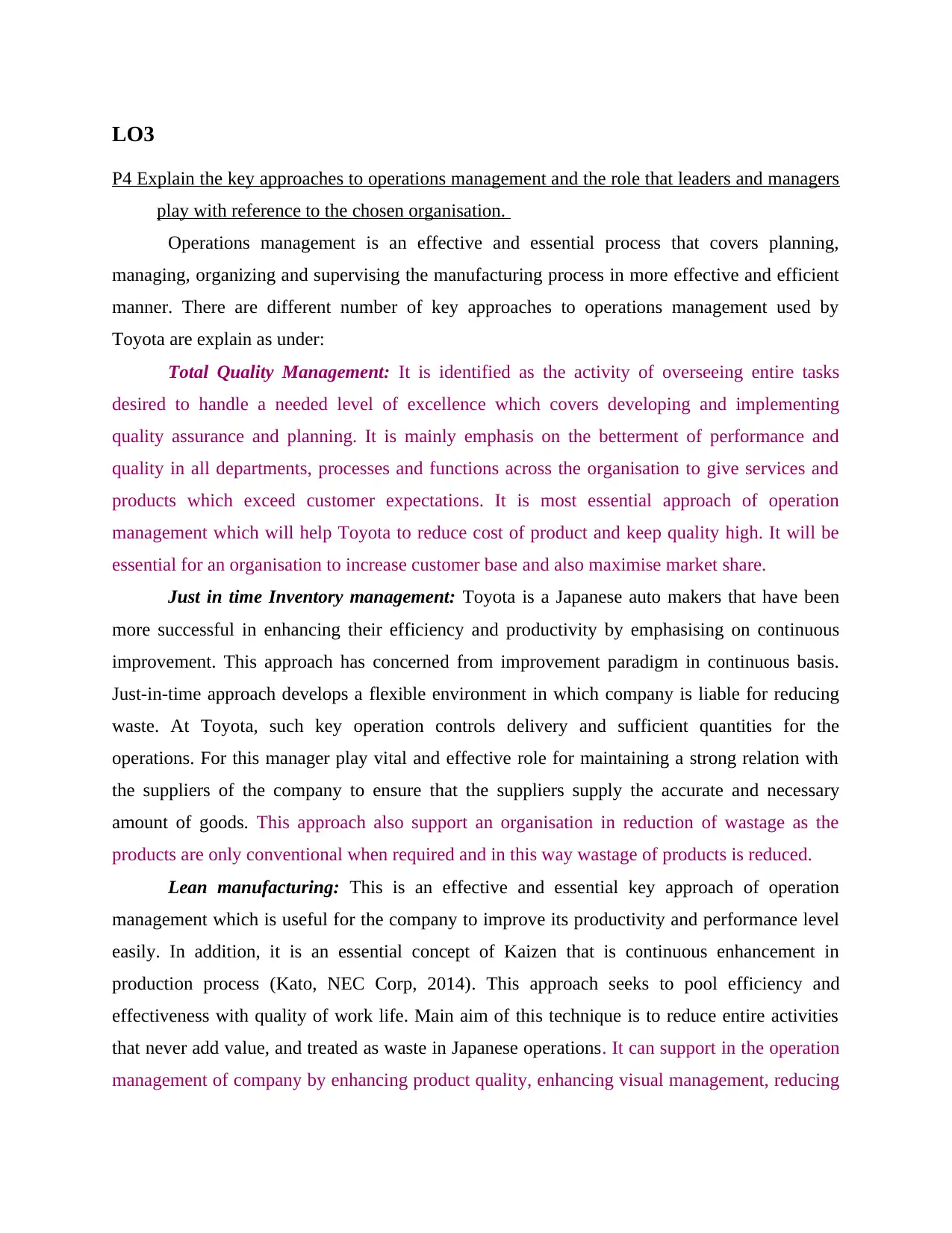
LO3
P4 Explain the key approaches to operations management and the role that leaders and managers
play with reference to the chosen organisation.
Operations management is an effective and essential process that covers planning,
managing, organizing and supervising the manufacturing process in more effective and efficient
manner. There are different number of key approaches to operations management used by
Toyota are explain as under:
Total Quality Management: It is identified as the activity of overseeing entire tasks
desired to handle a needed level of excellence which covers developing and implementing
quality assurance and planning. It is mainly emphasis on the betterment of performance and
quality in all departments, processes and functions across the organisation to give services and
products which exceed customer expectations. It is most essential approach of operation
management which will help Toyota to reduce cost of product and keep quality high. It will be
essential for an organisation to increase customer base and also maximise market share.
Just in time Inventory management: Toyota is a Japanese auto makers that have been
more successful in enhancing their efficiency and productivity by emphasising on continuous
improvement. This approach has concerned from improvement paradigm in continuous basis.
Just-in-time approach develops a flexible environment in which company is liable for reducing
waste. At Toyota, such key operation controls delivery and sufficient quantities for the
operations. For this manager play vital and effective role for maintaining a strong relation with
the suppliers of the company to ensure that the suppliers supply the accurate and necessary
amount of goods. This approach also support an organisation in reduction of wastage as the
products are only conventional when required and in this way wastage of products is reduced.
Lean manufacturing: This is an effective and essential key approach of operation
management which is useful for the company to improve its productivity and performance level
easily. In addition, it is an essential concept of Kaizen that is continuous enhancement in
production process (Kato, NEC Corp, 2014). This approach seeks to pool efficiency and
effectiveness with quality of work life. Main aim of this technique is to reduce entire activities
that never add value, and treated as waste in Japanese operations. It can support in the operation
management of company by enhancing product quality, enhancing visual management, reducing
P4 Explain the key approaches to operations management and the role that leaders and managers
play with reference to the chosen organisation.
Operations management is an effective and essential process that covers planning,
managing, organizing and supervising the manufacturing process in more effective and efficient
manner. There are different number of key approaches to operations management used by
Toyota are explain as under:
Total Quality Management: It is identified as the activity of overseeing entire tasks
desired to handle a needed level of excellence which covers developing and implementing
quality assurance and planning. It is mainly emphasis on the betterment of performance and
quality in all departments, processes and functions across the organisation to give services and
products which exceed customer expectations. It is most essential approach of operation
management which will help Toyota to reduce cost of product and keep quality high. It will be
essential for an organisation to increase customer base and also maximise market share.
Just in time Inventory management: Toyota is a Japanese auto makers that have been
more successful in enhancing their efficiency and productivity by emphasising on continuous
improvement. This approach has concerned from improvement paradigm in continuous basis.
Just-in-time approach develops a flexible environment in which company is liable for reducing
waste. At Toyota, such key operation controls delivery and sufficient quantities for the
operations. For this manager play vital and effective role for maintaining a strong relation with
the suppliers of the company to ensure that the suppliers supply the accurate and necessary
amount of goods. This approach also support an organisation in reduction of wastage as the
products are only conventional when required and in this way wastage of products is reduced.
Lean manufacturing: This is an effective and essential key approach of operation
management which is useful for the company to improve its productivity and performance level
easily. In addition, it is an essential concept of Kaizen that is continuous enhancement in
production process (Kato, NEC Corp, 2014). This approach seeks to pool efficiency and
effectiveness with quality of work life. Main aim of this technique is to reduce entire activities
that never add value, and treated as waste in Japanese operations. It can support in the operation
management of company by enhancing product quality, enhancing visual management, reducing
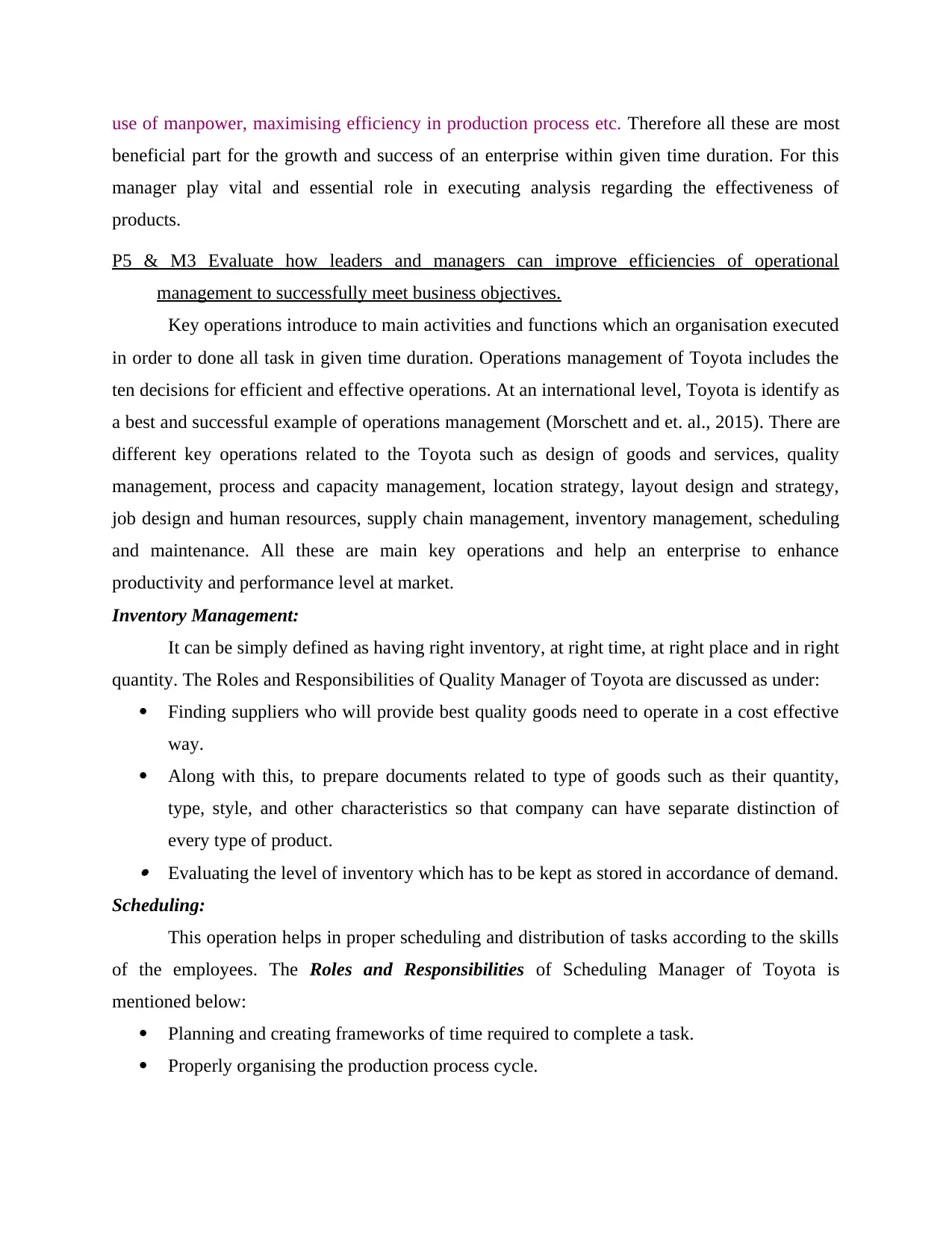
use of manpower, maximising efficiency in production process etc. Therefore all these are most
beneficial part for the growth and success of an enterprise within given time duration. For this
manager play vital and essential role in executing analysis regarding the effectiveness of
products.
P5 & M3 Evaluate how leaders and managers can improve efficiencies of operational
management to successfully meet business objectives.
Key operations introduce to main activities and functions which an organisation executed
in order to done all task in given time duration. Operations management of Toyota includes the
ten decisions for efficient and effective operations. At an international level, Toyota is identify as
a best and successful example of operations management (Morschett and et. al., 2015). There are
different key operations related to the Toyota such as design of goods and services, quality
management, process and capacity management, location strategy, layout design and strategy,
job design and human resources, supply chain management, inventory management, scheduling
and maintenance. All these are main key operations and help an enterprise to enhance
productivity and performance level at market.
Inventory Management:
It can be simply defined as having right inventory, at right time, at right place and in right
quantity. The Roles and Responsibilities of Quality Manager of Toyota are discussed as under:
Finding suppliers who will provide best quality goods need to operate in a cost effective
way.
Along with this, to prepare documents related to type of goods such as their quantity,
type, style, and other characteristics so that company can have separate distinction of
every type of product. Evaluating the level of inventory which has to be kept as stored in accordance of demand.
Scheduling:
This operation helps in proper scheduling and distribution of tasks according to the skills
of the employees. The Roles and Responsibilities of Scheduling Manager of Toyota is
mentioned below:
Planning and creating frameworks of time required to complete a task.
Properly organising the production process cycle.
beneficial part for the growth and success of an enterprise within given time duration. For this
manager play vital and essential role in executing analysis regarding the effectiveness of
products.
P5 & M3 Evaluate how leaders and managers can improve efficiencies of operational
management to successfully meet business objectives.
Key operations introduce to main activities and functions which an organisation executed
in order to done all task in given time duration. Operations management of Toyota includes the
ten decisions for efficient and effective operations. At an international level, Toyota is identify as
a best and successful example of operations management (Morschett and et. al., 2015). There are
different key operations related to the Toyota such as design of goods and services, quality
management, process and capacity management, location strategy, layout design and strategy,
job design and human resources, supply chain management, inventory management, scheduling
and maintenance. All these are main key operations and help an enterprise to enhance
productivity and performance level at market.
Inventory Management:
It can be simply defined as having right inventory, at right time, at right place and in right
quantity. The Roles and Responsibilities of Quality Manager of Toyota are discussed as under:
Finding suppliers who will provide best quality goods need to operate in a cost effective
way.
Along with this, to prepare documents related to type of goods such as their quantity,
type, style, and other characteristics so that company can have separate distinction of
every type of product. Evaluating the level of inventory which has to be kept as stored in accordance of demand.
Scheduling:
This operation helps in proper scheduling and distribution of tasks according to the skills
of the employees. The Roles and Responsibilities of Scheduling Manager of Toyota is
mentioned below:
Planning and creating frameworks of time required to complete a task.
Properly organising the production process cycle.
Secure Best Marks with AI Grader
Need help grading? Try our AI Grader for instant feedback on your assignments.
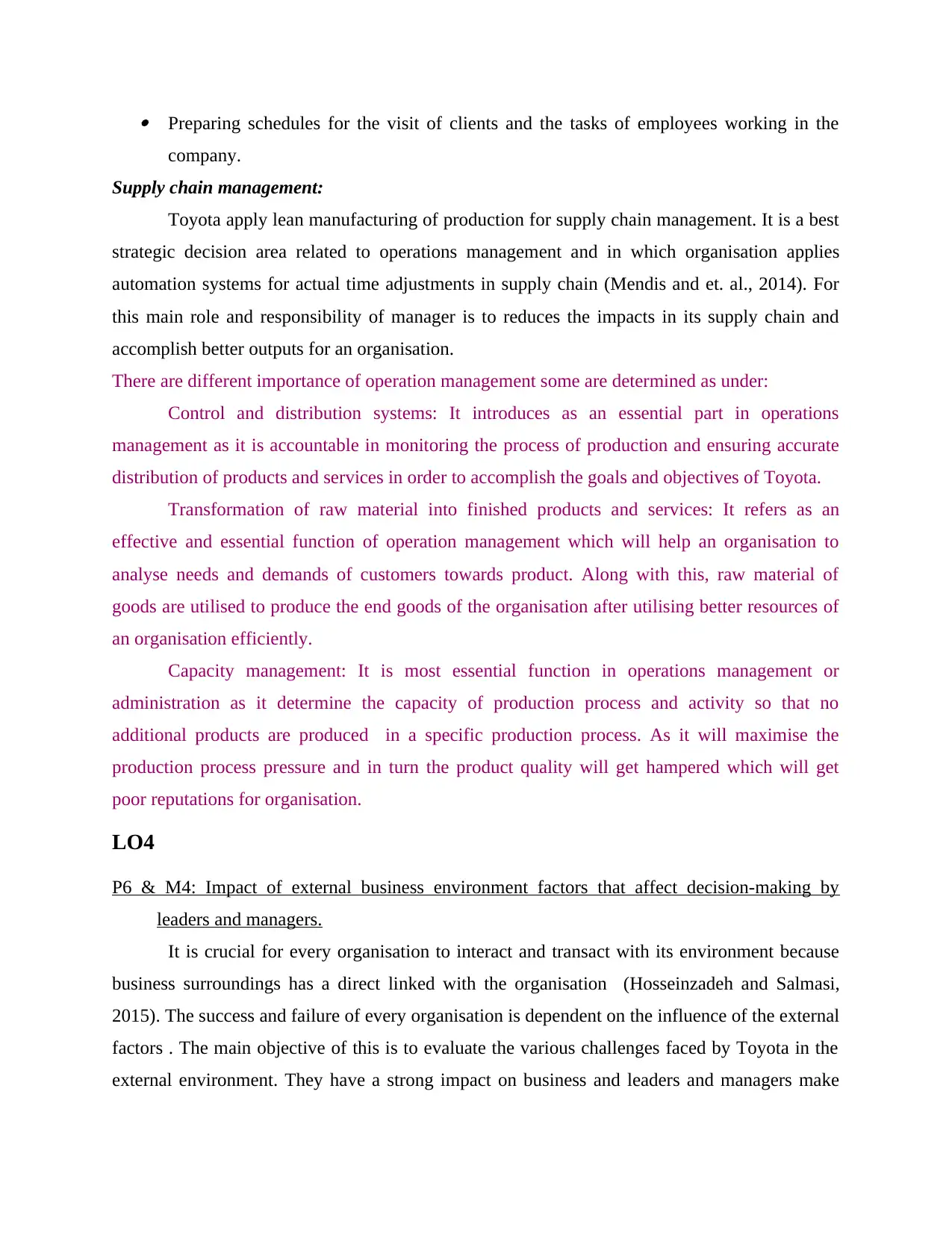
Preparing schedules for the visit of clients and the tasks of employees working in the
company.
Supply chain management:
Toyota apply lean manufacturing of production for supply chain management. It is a best
strategic decision area related to operations management and in which organisation applies
automation systems for actual time adjustments in supply chain (Mendis and et. al., 2014). For
this main role and responsibility of manager is to reduces the impacts in its supply chain and
accomplish better outputs for an organisation.
There are different importance of operation management some are determined as under:
Control and distribution systems: It introduces as an essential part in operations
management as it is accountable in monitoring the process of production and ensuring accurate
distribution of products and services in order to accomplish the goals and objectives of Toyota.
Transformation of raw material into finished products and services: It refers as an
effective and essential function of operation management which will help an organisation to
analyse needs and demands of customers towards product. Along with this, raw material of
goods are utilised to produce the end goods of the organisation after utilising better resources of
an organisation efficiently.
Capacity management: It is most essential function in operations management or
administration as it determine the capacity of production process and activity so that no
additional products are produced in a specific production process. As it will maximise the
production process pressure and in turn the product quality will get hampered which will get
poor reputations for organisation.
LO4
P6 & M4: Impact of external business environment factors that affect decision-making by
leaders and managers.
It is crucial for every organisation to interact and transact with its environment because
business surroundings has a direct linked with the organisation (Hosseinzadeh and Salmasi,
2015). The success and failure of every organisation is dependent on the influence of the external
factors . The main objective of this is to evaluate the various challenges faced by Toyota in the
external environment. They have a strong impact on business and leaders and managers make
company.
Supply chain management:
Toyota apply lean manufacturing of production for supply chain management. It is a best
strategic decision area related to operations management and in which organisation applies
automation systems for actual time adjustments in supply chain (Mendis and et. al., 2014). For
this main role and responsibility of manager is to reduces the impacts in its supply chain and
accomplish better outputs for an organisation.
There are different importance of operation management some are determined as under:
Control and distribution systems: It introduces as an essential part in operations
management as it is accountable in monitoring the process of production and ensuring accurate
distribution of products and services in order to accomplish the goals and objectives of Toyota.
Transformation of raw material into finished products and services: It refers as an
effective and essential function of operation management which will help an organisation to
analyse needs and demands of customers towards product. Along with this, raw material of
goods are utilised to produce the end goods of the organisation after utilising better resources of
an organisation efficiently.
Capacity management: It is most essential function in operations management or
administration as it determine the capacity of production process and activity so that no
additional products are produced in a specific production process. As it will maximise the
production process pressure and in turn the product quality will get hampered which will get
poor reputations for organisation.
LO4
P6 & M4: Impact of external business environment factors that affect decision-making by
leaders and managers.
It is crucial for every organisation to interact and transact with its environment because
business surroundings has a direct linked with the organisation (Hosseinzadeh and Salmasi,
2015). The success and failure of every organisation is dependent on the influence of the external
factors . The main objective of this is to evaluate the various challenges faced by Toyota in the
external environment. They have a strong impact on business and leaders and managers make
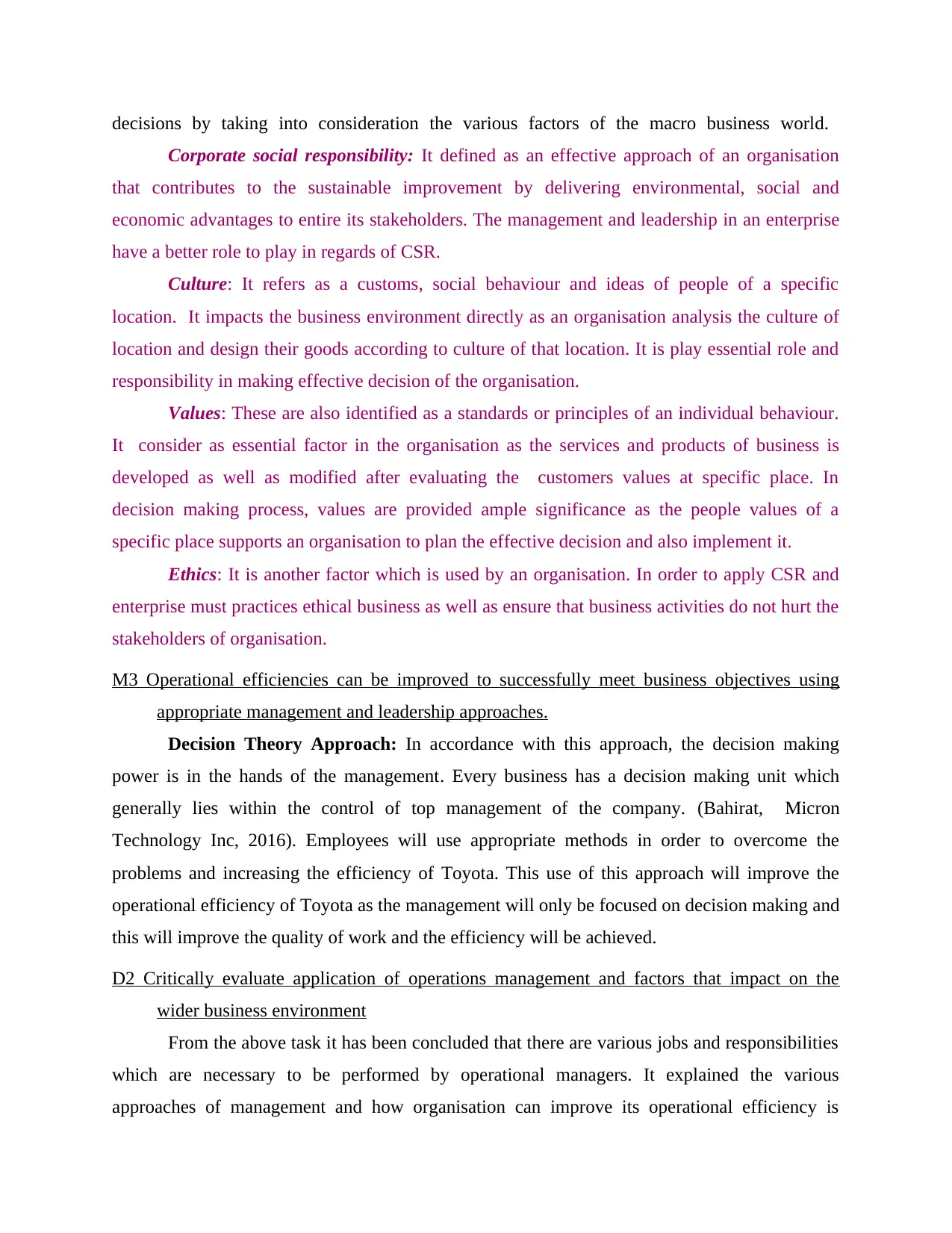
decisions by taking into consideration the various factors of the macro business world.
Corporate social responsibility: It defined as an effective approach of an organisation
that contributes to the sustainable improvement by delivering environmental, social and
economic advantages to entire its stakeholders. The management and leadership in an enterprise
have a better role to play in regards of CSR.
Culture: It refers as a customs, social behaviour and ideas of people of a specific
location. It impacts the business environment directly as an organisation analysis the culture of
location and design their goods according to culture of that location. It is play essential role and
responsibility in making effective decision of the organisation.
Values: These are also identified as a standards or principles of an individual behaviour.
It consider as essential factor in the organisation as the services and products of business is
developed as well as modified after evaluating the customers values at specific place. In
decision making process, values are provided ample significance as the people values of a
specific place supports an organisation to plan the effective decision and also implement it.
Ethics: It is another factor which is used by an organisation. In order to apply CSR and
enterprise must practices ethical business as well as ensure that business activities do not hurt the
stakeholders of organisation.
M3 Operational efficiencies can be improved to successfully meet business objectives using
appropriate management and leadership approaches.
Decision Theory Approach: In accordance with this approach, the decision making
power is in the hands of the management. Every business has a decision making unit which
generally lies within the control of top management of the company. (Bahirat, Micron
Technology Inc, 2016). Employees will use appropriate methods in order to overcome the
problems and increasing the efficiency of Toyota. This use of this approach will improve the
operational efficiency of Toyota as the management will only be focused on decision making and
this will improve the quality of work and the efficiency will be achieved.
D2 Critically evaluate application of operations management and factors that impact on the
wider business environment
From the above task it has been concluded that there are various jobs and responsibilities
which are necessary to be performed by operational managers. It explained the various
approaches of management and how organisation can improve its operational efficiency is
Corporate social responsibility: It defined as an effective approach of an organisation
that contributes to the sustainable improvement by delivering environmental, social and
economic advantages to entire its stakeholders. The management and leadership in an enterprise
have a better role to play in regards of CSR.
Culture: It refers as a customs, social behaviour and ideas of people of a specific
location. It impacts the business environment directly as an organisation analysis the culture of
location and design their goods according to culture of that location. It is play essential role and
responsibility in making effective decision of the organisation.
Values: These are also identified as a standards or principles of an individual behaviour.
It consider as essential factor in the organisation as the services and products of business is
developed as well as modified after evaluating the customers values at specific place. In
decision making process, values are provided ample significance as the people values of a
specific place supports an organisation to plan the effective decision and also implement it.
Ethics: It is another factor which is used by an organisation. In order to apply CSR and
enterprise must practices ethical business as well as ensure that business activities do not hurt the
stakeholders of organisation.
M3 Operational efficiencies can be improved to successfully meet business objectives using
appropriate management and leadership approaches.
Decision Theory Approach: In accordance with this approach, the decision making
power is in the hands of the management. Every business has a decision making unit which
generally lies within the control of top management of the company. (Bahirat, Micron
Technology Inc, 2016). Employees will use appropriate methods in order to overcome the
problems and increasing the efficiency of Toyota. This use of this approach will improve the
operational efficiency of Toyota as the management will only be focused on decision making and
this will improve the quality of work and the efficiency will be achieved.
D2 Critically evaluate application of operations management and factors that impact on the
wider business environment
From the above task it has been concluded that there are various jobs and responsibilities
which are necessary to be performed by operational managers. It explained the various
approaches of management and how organisation can improve its operational efficiency is
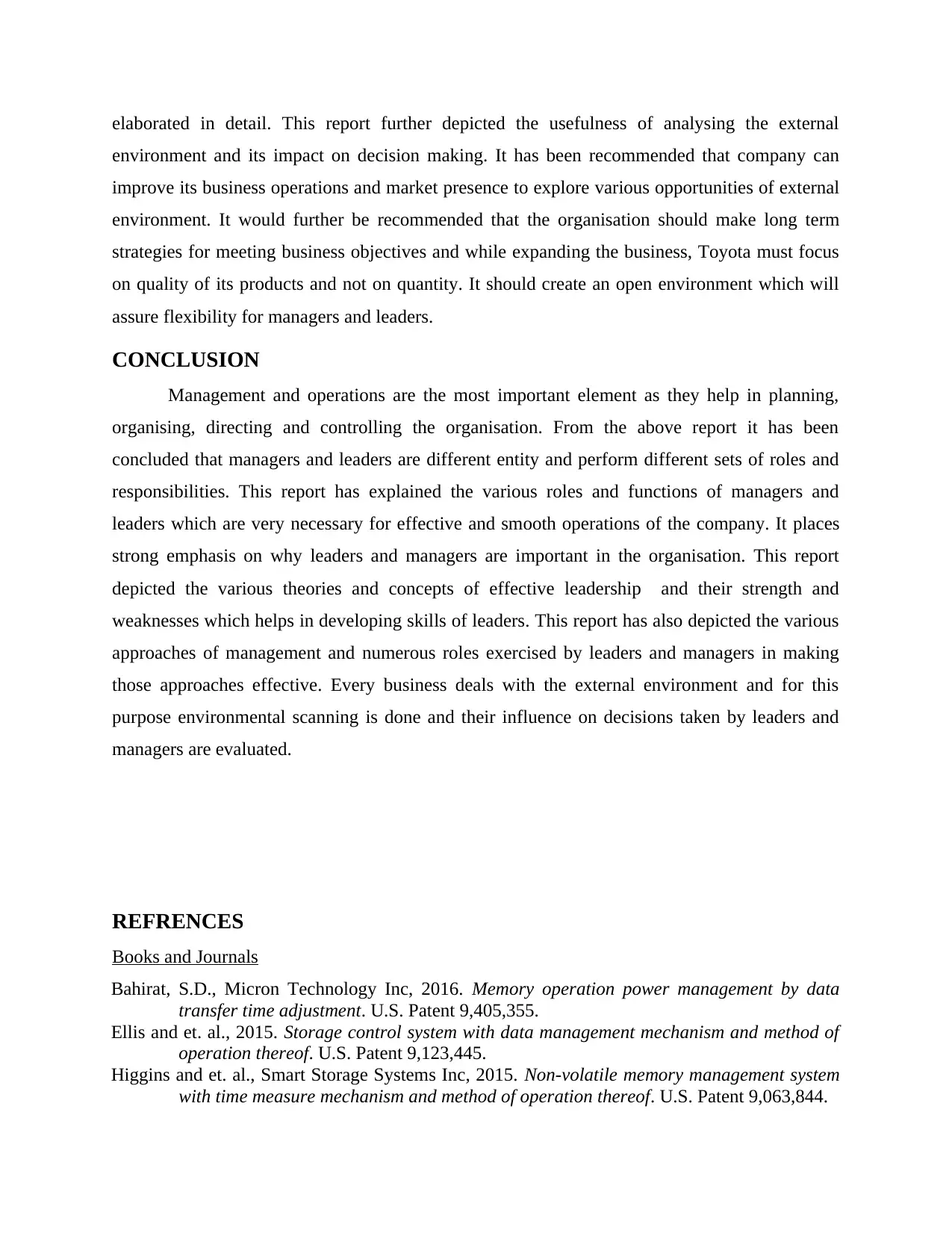
elaborated in detail. This report further depicted the usefulness of analysing the external
environment and its impact on decision making. It has been recommended that company can
improve its business operations and market presence to explore various opportunities of external
environment. It would further be recommended that the organisation should make long term
strategies for meeting business objectives and while expanding the business, Toyota must focus
on quality of its products and not on quantity. It should create an open environment which will
assure flexibility for managers and leaders.
CONCLUSION
Management and operations are the most important element as they help in planning,
organising, directing and controlling the organisation. From the above report it has been
concluded that managers and leaders are different entity and perform different sets of roles and
responsibilities. This report has explained the various roles and functions of managers and
leaders which are very necessary for effective and smooth operations of the company. It places
strong emphasis on why leaders and managers are important in the organisation. This report
depicted the various theories and concepts of effective leadership and their strength and
weaknesses which helps in developing skills of leaders. This report has also depicted the various
approaches of management and numerous roles exercised by leaders and managers in making
those approaches effective. Every business deals with the external environment and for this
purpose environmental scanning is done and their influence on decisions taken by leaders and
managers are evaluated.
REFRENCES
Books and Journals
Bahirat, S.D., Micron Technology Inc, 2016. Memory operation power management by data
transfer time adjustment. U.S. Patent 9,405,355.
Ellis and et. al., 2015. Storage control system with data management mechanism and method of
operation thereof. U.S. Patent 9,123,445.
Higgins and et. al., Smart Storage Systems Inc, 2015. Non-volatile memory management system
with time measure mechanism and method of operation thereof. U.S. Patent 9,063,844.
environment and its impact on decision making. It has been recommended that company can
improve its business operations and market presence to explore various opportunities of external
environment. It would further be recommended that the organisation should make long term
strategies for meeting business objectives and while expanding the business, Toyota must focus
on quality of its products and not on quantity. It should create an open environment which will
assure flexibility for managers and leaders.
CONCLUSION
Management and operations are the most important element as they help in planning,
organising, directing and controlling the organisation. From the above report it has been
concluded that managers and leaders are different entity and perform different sets of roles and
responsibilities. This report has explained the various roles and functions of managers and
leaders which are very necessary for effective and smooth operations of the company. It places
strong emphasis on why leaders and managers are important in the organisation. This report
depicted the various theories and concepts of effective leadership and their strength and
weaknesses which helps in developing skills of leaders. This report has also depicted the various
approaches of management and numerous roles exercised by leaders and managers in making
those approaches effective. Every business deals with the external environment and for this
purpose environmental scanning is done and their influence on decisions taken by leaders and
managers are evaluated.
REFRENCES
Books and Journals
Bahirat, S.D., Micron Technology Inc, 2016. Memory operation power management by data
transfer time adjustment. U.S. Patent 9,405,355.
Ellis and et. al., 2015. Storage control system with data management mechanism and method of
operation thereof. U.S. Patent 9,123,445.
Higgins and et. al., Smart Storage Systems Inc, 2015. Non-volatile memory management system
with time measure mechanism and method of operation thereof. U.S. Patent 9,063,844.
Paraphrase This Document
Need a fresh take? Get an instant paraphrase of this document with our AI Paraphraser
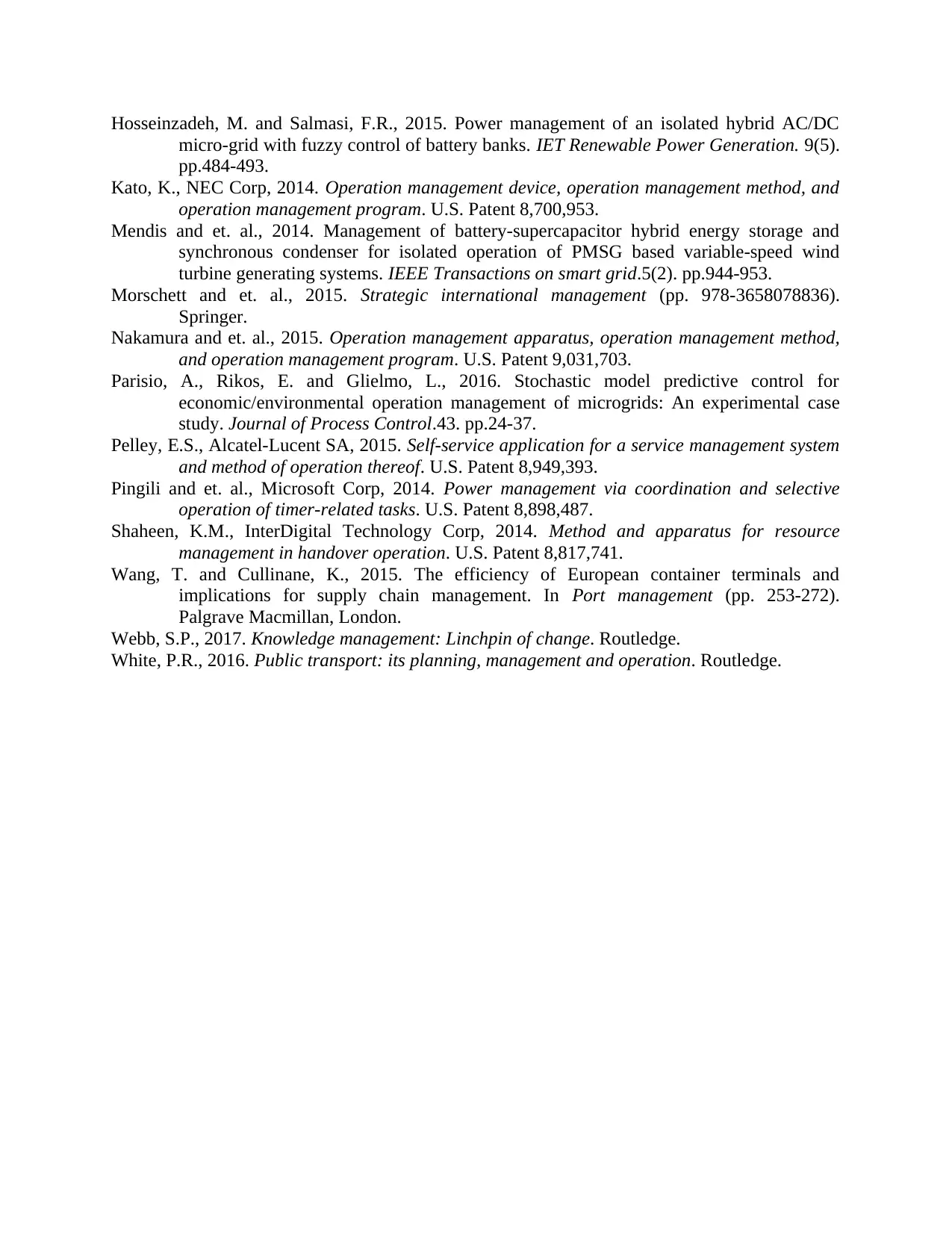
Hosseinzadeh, M. and Salmasi, F.R., 2015. Power management of an isolated hybrid AC/DC
micro-grid with fuzzy control of battery banks. IET Renewable Power Generation. 9(5).
pp.484-493.
Kato, K., NEC Corp, 2014. Operation management device, operation management method, and
operation management program. U.S. Patent 8,700,953.
Mendis and et. al., 2014. Management of battery-supercapacitor hybrid energy storage and
synchronous condenser for isolated operation of PMSG based variable-speed wind
turbine generating systems. IEEE Transactions on smart grid.5(2). pp.944-953.
Morschett and et. al., 2015. Strategic international management (pp. 978-3658078836).
Springer.
Nakamura and et. al., 2015. Operation management apparatus, operation management method,
and operation management program. U.S. Patent 9,031,703.
Parisio, A., Rikos, E. and Glielmo, L., 2016. Stochastic model predictive control for
economic/environmental operation management of microgrids: An experimental case
study. Journal of Process Control.43. pp.24-37.
Pelley, E.S., Alcatel-Lucent SA, 2015. Self-service application for a service management system
and method of operation thereof. U.S. Patent 8,949,393.
Pingili and et. al., Microsoft Corp, 2014. Power management via coordination and selective
operation of timer-related tasks. U.S. Patent 8,898,487.
Shaheen, K.M., InterDigital Technology Corp, 2014. Method and apparatus for resource
management in handover operation. U.S. Patent 8,817,741.
Wang, T. and Cullinane, K., 2015. The efficiency of European container terminals and
implications for supply chain management. In Port management (pp. 253-272).
Palgrave Macmillan, London.
Webb, S.P., 2017. Knowledge management: Linchpin of change. Routledge.
White, P.R., 2016. Public transport: its planning, management and operation. Routledge.
micro-grid with fuzzy control of battery banks. IET Renewable Power Generation. 9(5).
pp.484-493.
Kato, K., NEC Corp, 2014. Operation management device, operation management method, and
operation management program. U.S. Patent 8,700,953.
Mendis and et. al., 2014. Management of battery-supercapacitor hybrid energy storage and
synchronous condenser for isolated operation of PMSG based variable-speed wind
turbine generating systems. IEEE Transactions on smart grid.5(2). pp.944-953.
Morschett and et. al., 2015. Strategic international management (pp. 978-3658078836).
Springer.
Nakamura and et. al., 2015. Operation management apparatus, operation management method,
and operation management program. U.S. Patent 9,031,703.
Parisio, A., Rikos, E. and Glielmo, L., 2016. Stochastic model predictive control for
economic/environmental operation management of microgrids: An experimental case
study. Journal of Process Control.43. pp.24-37.
Pelley, E.S., Alcatel-Lucent SA, 2015. Self-service application for a service management system
and method of operation thereof. U.S. Patent 8,949,393.
Pingili and et. al., Microsoft Corp, 2014. Power management via coordination and selective
operation of timer-related tasks. U.S. Patent 8,898,487.
Shaheen, K.M., InterDigital Technology Corp, 2014. Method and apparatus for resource
management in handover operation. U.S. Patent 8,817,741.
Wang, T. and Cullinane, K., 2015. The efficiency of European container terminals and
implications for supply chain management. In Port management (pp. 253-272).
Palgrave Macmillan, London.
Webb, S.P., 2017. Knowledge management: Linchpin of change. Routledge.
White, P.R., 2016. Public transport: its planning, management and operation. Routledge.
1 out of 14
Related Documents
Your All-in-One AI-Powered Toolkit for Academic Success.
+13062052269
info@desklib.com
Available 24*7 on WhatsApp / Email
![[object Object]](/_next/static/media/star-bottom.7253800d.svg)
Unlock your academic potential
© 2024 | Zucol Services PVT LTD | All rights reserved.





